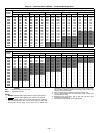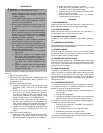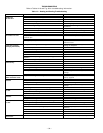
—
34
—
TROUBLESHOOTING
Refer to Tables 14-16 and Fig. 46 for troubleshooting information.
Table 14 — Heating and Cooling Troubleshooting
PROBLEM CAUSE REMEDY
Compressor and
outdoor fan
will not start.
Power failure. Call power company.
Fuse blown or circuit breaker tripped. Replace fuse or reset circuit breaker.
Defective thermostat, contactor, transformer, or control relay. Replace component.
Insufficient line voltage. Determine cause and correct.
Incorrect or faulty wiring. Check wiring diagram and rewire correctly.
Thermostat setting too high. Lower thermostat setting below room
temperature.
High-pressure switch tripped. See problem ‘‘Excessive head pressure.’’
Low-pressure switch tripped. Check for leaks, repair, and recharge.
Freeze-up protection thermostat tripped. See problem ‘‘Suction pressure too low.’’
Compressor will not start
but outdoor fan runs.
Faulty wiring or loose connections in compressor circuit. Check wiring and repair or replace.
Compressor motor burned out, seized, or internal
overload open.
Determine cause. Replace compressor.
Defective overload. Determine cause and replace.
One leg of 3-phase power dead. Replace fuse or reset circuit breaker.
Determine cause.
Compressor cycles
(other than normally
satisfying thermostat).
Refrigerant overcharge or undercharge. Recover refrigerant, evacuate system, and
recharge to nameplate.
Defective compressor. Replace and determine cause.
Insufficient line voltage. Determine cause and correct.
Blocked outdoor coil or dirty air filter. Determine cause and correct.
Defective overload. Determine cause and replace.
Defective thermostat. Replace thermostat.
Faulty outdoor-fan (cooling) or indoor-fan (heating) motor or
capacitor.
Replace.
Restriction in refrigerant system. Locate restriction and remove.
Compressor operates
continuously.
Dirty air filter. Replace filter.
Unit undersized for load. Decrease load or increase unit size.
Thermostat set too low. Reset thermostat.
Low refrigerant charge. Locate leak, repair, and recharge.
Leaking valves in compressor. Replace compressor.
Air in system. Recover refrigerant, evacuate system, and
recharge.
Outdoor coil dirty or restricted. Clean coil or remove restriction.
Scroll compressor
makes excessive noise.
Compressor rotating in the wrong direction. Reverse the 3-phase power leads as described in
Start-Up, page 28.
Excessive head
pressure
Dirty air filter. Replace filter.
Dirty outdoor coil. Clean coil.
Refrigerant overcharged. Remove excess refrigerant.
Air in system. Recover refrigerant, evacuate system, and
recharge.
Condensing air restricted or air short-cycling. Determine cause and correct.
Head pressure
too low.
Low refrigerant charge. Check for leaks, repair, and recharge.
Compressor valves leaking. Replace compressor.
Restriction in liquid tube. Remove restriction.
Excessive suction
pressure.
High heat load. Check for source and eliminate.
Compressor valves leaking. Replace compressor.
Refrigerant overcharged. Recover excess refrigerant.
Suction pressure
too low.
Dirty air filter (cooling) or dirty outdoor coil (heating). Replace filter or clean coil.
Low refrigerant charge. Check for leaks, repair, and recharge.
Metering device or low side restricted Remove source of restriction.
Insufficient indoor airflow (cooling mode). Increase air quantity. Check filter and replace if
necessary.
Temperature too low in conditioned area. Reset thermostat.
Field-installed filter drier restricted. Replace.
Outdoor ambient temperature below 25 F. Install low-ambient kit.
Compressor no. 2
will not run.
Unit in economizer mode. Proper operation; no remedy necessary.


















